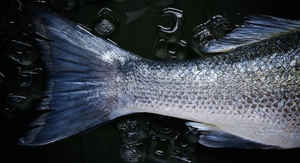
North Carolina Symbols
North Carolina State Freshwater Trout
Southern Appalachian Brook Trout

(Salvelinus fontinalis)
Adopted on September 13, 2005.
The General Assembly of 2005 named the Southern Appalachian Brook Trout as the official Freshwater Trout for the State of North Carolina (Session
Laws, 2005, c. 387).
The Southern Appalachian Brook Trout (Salvelinus fontinalis) is a genetically distinct species that is North Carolina's only native freshwater
trout. Sometimes known as "specks" because of their unique spotted appearance, the Brook trout is a favorite of sport fishermen in the cold
mountain streams of Western North Carolina, as well as in Tennessee, Arkansas, Georgia, South Carolina, and Kentucky.
North Carolina State Freshwater
Trout:
Southern Appalachian Brook Trout
Southern Appalachian Brook Trout Distinct Species?
According to the Information Services Branch of the State Library of North Carolina:
The Southern Appalachian Brook Trout (Salvelinus fontinalis) is a genetically distinct species that is North Carolina's only native freshwater trout. Sometimes known as "specks" because of their unique spotted appearance, the Brook trout is a favorite of sport fishermen in the cold mountain streams of Western North Carolina, as well as in Tennessee, Arkansas, Georgia, South Carolina, and Kentucky.

Currently, most states in the southeastern U.S. have trout fisheries that typically consist of rainbow trout, brown trout (which are native to Europe
and western Asia), brook trout, or some combination of these. A few other species, such as lake trout and cutthroat trout, also provide fisheries in
some places and a few others, such as kokanee salmon, have been tried unsuccessfully over the years. Coldwater habitats managed for trout in the region
now include spring fed streams, tailwaters, and some reservoirs. Historically, however, coldwater habitat supporting native trout was limited to streams
in the southern Appalachian Mountains of Virginia, Tennessee, North Carolina, South Carolina, and Georgia. And the only salmonid inhabiting these streams
was the brook trout.
But these weren't (and aren't) just any brook trout. Genetic studies over the past decade have shown that brook native to the southern Appalachians
(south of the New River in Virginia) are quite distinct from brook trout stocks native to the central Appalachians, New England, or other parts of
the species' native range. In fact, genetic difference between the brook trout that have been isolated in the southern Appalachians since the end of
the last glacial period (10-15 thousand years ago) and other brook trout stocks approaches the level characteristic of subspecies. Although southern
Appalachian fish have not yet been officially recognized as a separate brook trout subspecies (more study is needed), they are the region's only truly
native salmonid and are important parts of its ecological integrity and angling legacy.
Much of the original range of native southern Appalachian brook trout was lost during the early 20th century through habitat degradation, primarily caused by the poor logging practices of the day. Rainbow trout (and later, brown trout) were introduced as habitat quality improved and demand for trout fisheries increased. However, populations of these nonnative fish expanded into waters formerly occupied by brook trout and in some cases displaced existing brook trout populations. Concern about the loss of native brook trout distribution led to restoration efforts involving stocked brook trout. Because fishery managers were unaware of the distinctiveness of the native fish, brook trout from northeastern U.S. stocks were used because they were much easier to culture at hatcheries. These "hatcher" brook trout were widely stocked for years, resulting in wild brook trout populations consisting of native fish, hatchery descendants, or hybrids.
Characteristics of the Southern Appalachian Brook Trout
The average length is 10-12 inches but Brook Trout can be caught measuring up to 21 inches and weighing 4-6 pounds. The largest Brook trout on record was 14.5 pounds and caught in 1916 in the Nipigon River in Ontario. Breeding males develop a hook at the front of the lower jaw. Typical coloring is olive-green to dark brown on the back with silvery sides and pale spotting. All colors intensify at spawning time.
Distribution
The brook trout is native to northern North America and is widely distributed throughout the maritime provinces. It occurs in clear, cool, well-oxygenated streams and lakes.
Foods
Brook trout are opportunistic feeders and will eat whatever they can find. In small streams they prefer aquatic insects (nymphs) that live under the rocks and along the stream bottom. They are also known to feed heavily on the adult stage of aquatic insects as they hatch and take flight during their brief courtship and egg laying cycle. Land insects, like ants and beetles, that fall into the water are readily eaten as are small crayfish. They will eat other small fish and minnows but only when they are easy to catch.
Biology
This species spawns in late summer or autumn in gravel beds in the shallows of headwaters of streams. The female digs the redd where she lays 100-5000 eggs depending on her size. They hatch 50-100 days later. The life expectancy is an average of five years. The brook trout is carnivorous and feed upon a wide range of organisms. They have been known to eat their own eggs at spawning time and even their own young.
GENERAL ASSEMBLY OF NORTH CAROLINA
SESSION 2005
SESSION LAW 2005-387
HOUSE BILL 1316
AN ACT adopting the fraser fir as the official christmas tree of the state of north carolina and the southern appalachian brook trout as the official
freshwater trout of north carolina.
Whereas, North Carolina has 1,500 Christmas tree growers and produces more trees than any other state except Oregon; and
Whereas, North Carolina tree growers produce over 50 million Fraser firs each year; and
Whereas, the Fraser fir constitutes more than 90% of all the Christmas trees grown in North Carolina; and
Whereas, the Fraser fir is named for John Fraser, a Scottish botanist who explored the Southern Appalachian mountains of North Carolina in the late
1700s; and
Whereas, the Fraser fir is a pyramid-shaped tree that reaches a maximum height of 80 feet and a trunk diameter of one to one and one-half
feet; and
Whereas, the Fraser fir grows naturally only in the Southern Appalachians; and
Whereas, Fraser fir trees grown in North Carolina have won the National Christmas Tree Association's annual tree competition more than any other species;
and
Whereas, North Carolina contains innumerable mountain streams and coldwater fisheries habitats; and
Whereas, these mountain streams are home to brook trout (Salvelinus fontinalis), which is North Carolina's only native freshwater trout species; and
Whereas, the Southern Appalachian form of brook trout is a scientifically-recognized unique and genetically distinct form locally known as "specks"
or "speckle" trout because of the numerous specks on its skin; and
Whereas, North Carolina is home to some 400 self-sustaining populations of Southern Appalachian brook trout, more than in any other state; and
Whereas, these wild and colorful fish are important keystones of ecological diversity, indicators of outstanding water quality, and representatives
of the pure and unspoiled areas that they inhabit; and
Whereas, Southern Appalachian brook trout are cooperative sport fish, and may be caught by anglers using traditional fly-fishing equipment and
locally-adapted fly patterns, thereby supporting extensive recreational fishing opportunities, economic development, and tourism; and
Whereas, by their character and contribution, these unique fish are woven into the historical and cultural fabric of Western North Carolina; and
Whereas, the Fraser fir deserves recognition as the official Christmas tree of the State of North Carolina and the Southern Appalachian brook trout
deserves recognition as the official freshwater trout of the State of North Carolina; Now, therefore,
The General Assembly of North Carolina enacts:
SECTION 1. Chapter 145 of the General Statutes is amended by adding a new section to read:
"§ 145-25. State Christmas tree.
The Fraser fir (Abies fraseri) is adopted as the official Christmas tree of the State of North Carolina."
SECTION 2. Chapter 145 of the General Statutes is amended by adding a new section to read:
"§ 145-26. State freshwater trout.
The Southern Appalachian strain of brook trout (Salvelinus fontinalis) is adopted as the official freshwater trout of the State of North Carolina."
SECTION 3. This act is effective when it becomes law.
In the General Assembly read three times and ratified this the 23rd day of August, 2005.
s/ Beverly E. Perdue
President of the Senate
s/ James B. Black
Speaker of the House of Representatives
s/ Michael F. Easley
Governor
Approved 3:25 p.m. this 13th day of September, 2005
North Carolina Law
The law designating the Southern Appalachian strain of brook trout as the official North Carolina freshwater trout is Section 145-26 (State freshwater trout ) of the North Carolina General Statutes Chapter 145 (State Symbols and Other Official Adoptions) Section 145-26
Chapter 145: State Symbols and Other Official Adoptions.
SECTION 145-26.
§ 145-26. State freshwater trout.
State Fish--Southern Appalachian strain of brook trout.
The Southern Appalachian strain of brook trout (Salvelinus fontinalis) is adopted as the official freshwater trout of the State of North Carolina.
(2005-387, s. 2.)
Taxonomic Hierarchy: Brook Trout
Kingdom: Animalia - animals
Phylum: Chordata - chordates
Subphylum: Vertebrata
Superclass: Osteichthyes - bony fishes
Class: Actinopterygii - ray-finned and spiny rayed fishes
Order: Salmoniformes - salmon and trout
Family: Salmonidae - salmon and trout
Genus: Salvelinus --
Species: Salvelinus fontinalis







